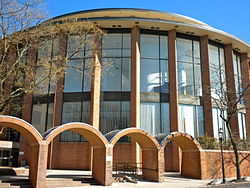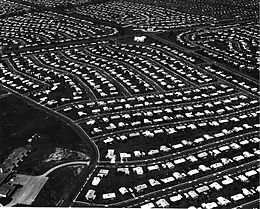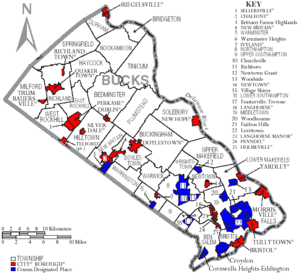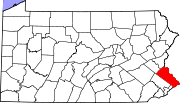- Bucks County, Pennsylvania
-
Bucks County, Pennsylvania Bucks County Courthouse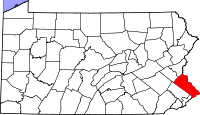
Location in the state of Pennsylvania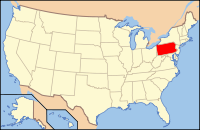
Pennsylvania's location in the U.S.Founded November 1682 Seat Doylestown Largest city Bensalem Area
- Total
- Land
- Water
622 sq mi (1,611 km²)
607 sq mi (1,572 km²)
15 sq mi (39 km²), 2.37%Population
- (2010)
- Density
625,249
1,030/sq mi (397.7/km²)Website www.buckscounty.org Bucks County is a county located in the U.S. state (commonwealth) of Pennsylvania. The county seat is Doylestown. This county is part of the Delaware Valley area.
As of 2010, the population was 625,249. This makes Bucks the fourth most populous county in Pennsylvania (after Philadelphia, Allegheny, and Montgomery counties), and the 95th most populous county in the United States. As of 2000, it is the 76th wealthiest county in the nation as measured by median family income.
Contents
History
Founding
Bucks County was one of the three original counties in Pennsylvania. It was named by William Penn in 1682 after Buckinghamshire, England, the county where he lived and from which his family originated. Bucks is the abbreviation for Buckinghamshire, and both names are used interchangeably in England. Penn's home, Pennsbury Manor, is located within Bucks County.
Place names in Bucks County derived from places in Buckinghamshire include Buckingham, Chalfont (named after Chalfont St Giles), Wycombe and Solebury (spelled Soulbury in England). Buckingham was the former county town of Buckinghamshire; Buckingham, PA, (now known as Bristol, not to be confused with the present village of Buckingham, near Doylestown) was the county seat of Bucks County from 1705–1726. Chalfont St. Giles in Buckinghamshire was the parish home of William Penn's first wife, and the location of the Jordans Quaker Meeting House, where Penn is buried.
Bucks County was originally much larger than it is today. Northampton County was formed in 1752 from part of Bucks County, and Lehigh County was formed in 1812 from part of Northampton County.
Revolutionary War
In December 1776, Bucks County became the setting for Gen. George Washington and his troops as they prepared to cross the Delaware and storm Trenton, New Jersey on Christmas Day. The attack caught the Hessian army by surprise and would represent a turning point in the American War of Independence. The town of Washington Crossing, Pennsylvania and Washington Crossing Historic Park were named to commemorate the event.
See also: Washington's crossing of the DelawareLaw and government
The executive government is run by a three-seat Board of Commissioners, one member of which serves as chairperson. Commissioners are elected through at-large voting and serve four-year terms. In cases of vacancy, a panel of county judges appoints members to fill seats. The current commissioners are Charles H. Martin (R) (Chairman), Robert G. Loughery (R) (Vice-Chairman), and Diane M. Ellis-Marseglia (D). The current terms expire in January, 2012.[1]
Geography
Bucks County lies in the southeastern edge of the state along the Delaware River. Most of the land is typical of the piedmont region, with hills becoming more distinct further north. Unlike in the Southern Piedmont, soil in the Pennsylvania Piedmont has historically been fertile, giving Bucks County large areas of valuable farmland. With the decline of the farming industry, debate has arisen over how much of this open space should be preserved, and how much should be allotted for commercial and residential development.
The southern third of the county between Philadelphia and Trenton, New Jersey, often called Lower Bucks, resides in the Atlantic Coastal Plain, and is flat and near sea level, and the county's most populated and industrialized area.
The county shares most of its western border with Montgomery County, and also borders Philadelphia to the southwest, and Northampton and Lehigh Counties to the north. From north to south, it is linked to Warren, Hunterdon, Mercer and Burlington Counties in New Jersey by bridges.
Tohickon Creek and Neshaminy Creek are the largest tributaries of the Delaware in Bucks County. Tohickon Creek empties into the river at Point Pleasant and Neshaminy at Bristol.
According to the U.S. Census Bureau, the county has a total area of 622 square miles (1,611.0 km2). 607 square miles (1,572.1 km2) is land and 15 square miles (38.8 km2) (2.37%) is water.
Adjacent counties
- Lehigh County (northwest)
- Northampton County (north)
- Warren County, New Jersey (northeast)
- Hunterdon County, New Jersey (northeast)
- Mercer County, New Jersey (east)
- Burlington County, New Jersey (southeast)
- Philadelphia County (south)
- Montgomery County (west)
Industry and commerce
The boroughs of Bristol and Morrisville were prominent industrial centers along the Northeast Corridor during World War II. Suburban development accelerated in Lower Bucks in the 1950s with the opening of Levittown, Pennsylvania, the second such "Levittown" designed by William Levitt.
Among Bucks' largest employers in the twentieth century were U.S. Steel in Falls Township, and the Vulcanized Rubber & Plastics and Robertson Tile companies in Morrisville. Rohm and Haas continues to operate several chemical plants around Bristol. Waste Management operates a landfill in Tullytown that is largely the receptacle of out-of-state waste in the USA (receiving nearly all of New York City's waste following the closure of Fresh Kills landfill in Staten Island, NY 40 miles (64 km) away).[citation needed]
Bucks is also experiencing rapid growth in biotechnology, along with neighboring Montgomery County. The Greater Philadelphia area has become the second largest area of biotechnology in the United States, only behind Boston. It recently pushed San Francisco and Washington, D.C. to lower rankings. It is projected by 2020 that one out of four people in Bucks County will work in biotechnology.[2]\
Tourism
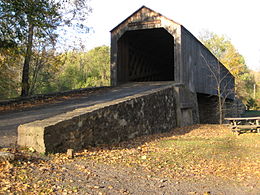 Bucks County is home to a number of covered bridges, 10 of which are still open to highway traffic and two others (situated in parks) are open to non-vehicular traffic.
Bucks County is home to a number of covered bridges, 10 of which are still open to highway traffic and two others (situated in parks) are open to non-vehicular traffic.
Another important asset of the county is tourism. The county's northern regions (colloquially referred to as Upper Bucks) are renowned for their natural scenery, farmland, colonial history, and proximity to major urban areas (particularly Philadelphia, but New York City, Allentown, Reading and Atlantic City are also within a two-hour radius).
Bucks County is home to ten covered bridges that are still open to vehicular traffic. Two other bridges, both located in parks, are open only to non-vehicular traffic. All Bucks County bridges use the Town truss design. The Schofield Ford Bridge, in Tyler State Park, was reconstructed in 1997 from the ground up after arsonists destroyed the original in 1991.[3]
Popular attractions in Bucks County include the shops and studios of New Hope, Peddler's Village (in Lahaska), Washington Crossing Historic Park, and Bucks County River Country. Rice's Market near Lahaska is a popular destination on Tuesday mornings. Quakertown Farmer's Market (locally called "Q-Mart") is a popular shopping destination on weekends. The county seat of Doylestown is also home to several points of interest for tourists, and also is home to Fordhook Farms, the famous trial farm of the Warminster-based Burpee Seeds, which also serves as a bed & breakfast inn. Doylestown also has the trifecta of concrete structures built by Henry Chapman Mercer, including the Moravian Pottery and Tile Works, the Mercer Museum and Fonthill, Mercer's personal home.
Southern Bucks (colloquially referred to as Lower Bucks) is home to two important shopping centers, Neshaminy Mall and Oxford Valley Mall, and Sesame Place, a family theme park based on the Sesame Street television series. Also within Lower Bucks County is the newly constructed Parx Casino in Bensalem. The casino was built on the grounds of the Philadelphia Park Racetrack, a renowned horse-racing park. The complex includes the expansive casino, a dance club, and numerous dining options. The complex will soon include a shopping district, and 1200+ housing units. Parx is soon expected to rival the casinos in nearby Atlantic City.
Local publications include Bucks County Courier Times, The Intelligencer, The Advance of Bucks County, Bucks County Herald, Bucks County Town and Country Living, LifeStyle Magazine, Nouveau, and BUCKS Magazine.
Population growth
Growth began in the early 1950s, when William Levitt chose Bucks County for his second "Levittown". Levitt bought hundreds of acres of woodlands and farmland, and constructed 17,000 homes and dozens of schools, parks, libraries, and shopping centers. By the time the project ended, the population of Levittown had swelled to almost 74,000 residents. At the time, only whites could buy homes. This rule however, was soon overturned. Other planned developments included Croydon and Fairless Hills. This rapid sprawl continued until the mid 1960s.
In the 1970s, a second growth spurt began. This time, developers took land in townships that were mostly untouched. These included Middletown, Lower Makefield Township, Northampton Township and Newtown Township. Tract housing, office complexes, shopping centers, and sprawling parking lots continued to move more and more towards Upper Bucks, swallowing horse farms, sprawling forests, and wetlands. At this time, the Oxford Valley Mall was constructed in Middletown, which would become the business nucleus of the county.
Growth has somewhat stabilized since the 1990s, with smaller increases and less development. However, the main reason for this is not a lack of population growth, but loss of land. Lower Bucks now lacks large parcels of land to develop. Smaller residential and commercial projects must now be constructed. However, redevelopment is now a leading coalition in Lower Bucks. Many areas along the Delaware River have surpluses of abandoned industry, so many municipalities have granted building rights to luxury housing developers. Also, as the regions that began the suburban boom in Bucks, such as Levittown, begin to reach their 50th anniversaries, many commercial strips and other neglected structures are being torn down to be replaced with new shopping plazas and commercial chains. Also, with rising property values, areas with older construction are beginning to have a "rebirth". At the same time, Central and Upper Bucks are still seeing rapid growth, with many municipalities doubling their populations.
Arts and culture
Fine and performing arts
Many artists and writers based in New York City have called Bucks County home, settling mainly in the small stretch between Doylestown, Pennsylvania and New Hope and along the Delaware River. Notable residents have included Margaret Mead, Pearl S. Buck, Oscar Hammerstein, II, Stephen Sondheim, Charlie Parker, Moss Hart, James Michener, Dorothy Parker, S. J. Perelman, Stan and Jan Berenstain, Alfred Bester, Annie Haslam, and Jean Toomer. Bucks County is the home of writer/musician James McBride, Academy Award-winning film composer Joe Renzetti, musician Gene Ween of Ween, painter Christopher Wajda ; photographer Michael Barone and was also home to furniture designer George Nakashima. James Gould Cozzens lived in Lambertville, New Jersey, just across the river from Bucks County, used Doylestown as the model for the setting of two novels, and is considered a Bucks County artist.
The county boasts many local theater companies, including the long-established Bucks County Playhouse in New Hope, Town and Country Players in Buckingham, PA and the Bristol Riverside Theatre, a professional Equity theater in Bristol.
The Wild River Review, an online magazine that publishes in-depth reporting, works of literature, art, visual art, reviews, interviews, and columns by and about contemporary artists, photographers, and writers, is based out of Doylestown.
Literature
The seemingly autobiographical novel The Fires of Spring by James Michener takes place in and around Doylestown.
Popular culture
Alecia Moore, more commonly known as Pink, was born in Doylestown as was motion picture writer and director, Stefan Avalos. Producer Samik Ganguly resides in Bucks County, as do two American Idol contestants: Justin Guarini, who was born in Atlanta, but moved to Bucks County; and Anthony Fedorov, who was born in Ukraine and was from Trevose, in Lower Southampton Township. Singer/actress Irene Molloy and classical tenor David Gordon were born in Doylestown. Collin Anderson, a commercial actor who often works with M. Night Shyamalan, was born in Bensalem and now resides in Holland, Bucks County. Musician Asher Roth was born in Morrisville.
Film
M. Night Shyamalan's 2002 film Signs, starring Mel Gibson, was filmed and takes place in Bucks County. The town scenes, in particular, were filmed on State Street in Newtown Borough, the drugstore scene was filmed at Burns' Pharmacy on Pennsylvania Avenue in Morrisville. The house was built on farmland privately owned and leased to Delaware Valley College in Doylestown Township, Pennsylvania. A stage set for some interior shots was created in a warehouse on State Road in Bensalem Township, Pennsylvania. Shyamalan's film, Lady in the Water, was shot across the street from the Bloomsdale section of Bristol Township. In addition, Shyamalan's next film, The Happening, filmed in Upper Bucks County, including Plumsteadville. [3][4]
With the exception of the Pine Barrens footage, all of The Last Broadcast was shot in Bucks County (though the name was changed).
A short scene from Stephen King's The Stand is based in Pipersville.
The producer Fred Bauer, the director Steve Rash and composer Joseph Renzetti of The Buddy Holly Story all live in Bucks County, where the film was conceived, and written by Bob Gittler.
Although filmed in California, one of Steven Spielberg's earliest films, Something Evil, is set in Bucks County.
The film Law Abiding Citizen starring Gerard Butler and Jamie Foxx was filmed partially in New Hope.[5]
The NBC pilot episode for Outlaw, starring Jimmy Smits filmed in the Andalusia section of Bensalem Township March 22–23, 2010.[4][5]
The Discoverers filmed in a variety of locations in Bucks County, including Croydon, Bristol, Newtown, New Hope, and Tyler State Park.[6][7]
The upcoming film Safe, starring Jason Statham filmed at Parx Racing and Casino in Bensalem.[8]
Sports
Football
- Buffalo Bills free safety Bryan Scott is a Bucks County native. He attended Central Bucks East High School.
- Former Philadelphia Eagles and Miami Dolphins star Troy Vincent resides in Lower Makefield and attended Pennsbury High School.
- Former Atlanta Falcons and Seattle Seahawks defensive end Patrick Kerney grew up in Newtown and attended Princeton Day School in New Jersey
- Miami Dolphins running back Steve Slaton is from Levittown. He attended Conwell-Egan Catholic High School in Fairless Hills. He then went on to play at West Virginia before going to the NFL.
Rugby League
The Bucks County Sharks rugby league team played in the AMNRL from 1997 and stopped playing for the 2010 season. However they did play one game.[6] They are returning to play in the AMNRL in 2011.
Little League
The county has a considerable history of producing Little League baseball contenders. Since its inception in 1947, four of the seven Pennsylvania teams to compete in the Little League World Series in Williamsport, Pennsylvania have come from Bucks County: Morrisville (1955), Levittown American (1960 and 1961), and Council Rock-Newtown (2005). Two of these squads, Morrisville and Levittown (1960), went on to win the World Series title. In 2007, Council Rock Northampton won the PA State championship, and lost in the finals of regionals.
American Legion Baseball
Bristol Legion Post 382 recently won the 2011 American Legion State Championship.
Horse racing
- Philadelphia Park Racetrack, formerly the home of Triple Crown contender Smarty Jones, is in Bensalem.
Parks and recreation
Pennsylvania state parks
There are six commonwealth-owned parks in Bucks County:
- Five are owned and operated by the Pennsylvania Bureau of State Parks, part of the Pennsylvania Department of Conservation and Natural Resources (DCNR).
- Bucks County Parks and Recreation operates a 18 bed youth hostel in the Nockamixon State Park Weisel estate. The hostel is part of Hostelling International USA.[7]
- Washington Crossing Historic Park is a 500 acres (2.0 km2) site operated by the Pennsylvania Historical and Museum Commission that is part of Washington's Crossing, a U.S. National Historic Landmark area. The park is headquartered in the village of Washington Crossing located in Upper Makefield Township. It marks the location of where George Washington crossed the Delaware River during the American Revolutionary War.
County parks
- Core Creek Park
- Dark Hollow Park
- Lake Towhee Park
- Peace Valley Park
- Playwicki Park
- Ringing Rocks Park
- Silver Lake Park
- Tinicum Park
- Tohickon Valley Park
- Bucks County Horse Park
Historic properties
- County owned
- Moravian Pottery and Tile Works
- Stover-Myers Mill; Erwin Stover House
- Moland House an old stone farmhouse built around 1750 located in Warwick Township, and served as the headquarters for General George Washington during the American Revolutionary War from August 10, 1777 until August 23, 1777.
- Pennsbury Manor house and grounds, the American home of William Penn, founder and first Governor of Pennsylvania, administered by the Pennsylvania Historical and Museum Commission in association with The Pennsbury Society and are open to the public.[8]
County recreation sites
- Frosty Hollow Tennis Center
- Core Creek Tennis Center
- Oxford Valley Golf Course
- Oxford Valley Pool
- Tohickon Valley Pool
- Weisel Hostel
- Peace Valley Boat Rental
- Core Creek Boat Rental
County nature centers
- Churchville Nature Center
- Peace Valley Nature Center
- Silver Lake Nature Center
Transportation
Airports
- Public airports administered by the Bucks County Airport Authority;
- Doylestown Airport
- Quakertown Airport
- Van Sant Airport and Park, formerly owned and administered by the Bucks County Department of Parks and Recreation
- Private Airports
- Pennridge Airport
- Sterling Aviation Heliport
Public Transportation
- SEPTA – only parts of SE Bucks County
- RUSHBUS – only parts of South and Central Bucks County
- Bucks County Transport or BCT – a paratransit and shared ride service
Politics
Presidential election results Year Republican Democratic 2008 45.2% 149,860 53.7% 178,345 2004 48.0% 154,469 51.2% 163,438 2000 46.3% 121,927 50.5% 132,914 1996 41.8% 94,899 45.5% 103,313 1992 38.1% 94,584 39.4% 97,902 1988 60.0% 127,563 38.8% 82,472 1984 63.3% 130,119 36.2% 74,568 1980 55.5% 100,536 32.6% 59,120 1976 50.7% 85,628 47.3% 79,838 1972 62.3% 99,684 35.5% 56,784 1968 48.6% 69,646 40.2% 57,634 1964 38.9% 50,243 60.6% 78,287 1960 54.0% 67,501 45.7% 57,177 As of January 2010, there are 430,557 registered voters in Bucks County [9].
- Democratic: 191,567 (44.49%)
- Republican: 176,517 (41.00%)
- Other Parties: 62,473 (14.51%)
Like Pennsylvania at large, Bucks County is regarded as a swing vote in major elections. Democratic registration there overtook the Republicans in early 2008. All four statewide winners (Barack Obama for President, Rob McCord for Treasurer, Jack Wagner for Auditor General, and Tom Corbett for Attorney General) carried Bucks in November 2008.
Bucks County was once a safeguard for the Republican Party, and although politically the county has diversified, Republicans still control most of the offices at local levels of government. County Republicans tend to hold moderate positions on environmental and social issues while advocating fiscal restraint.
Bucks County is represented in U.S. Congress by 8th Congressional district (map). While concerns about gerrymandering are on the rise, the 8th District remains one of the few districts in the United States that is almost fully made up by a single county. Since 2002, however, the 8th District has included small portions of neighboring Montgomery and Philadelphia counties.
County commissioners
- Charles Martin, Chairman, Republican
- Robert G. Loughery, Republican
- Diane Ellis-Marseglia, Democrat
Other county offices
- Clerk of Courts, Mary Smithson, Republican
- Comptroller, Ray McHugh, Republican
- Coroner, Joseph Campbell, Republican
- District Attorney, David Heckler, Republican
- Prothonotary, Patricia Bachtle, Republican
- Recorder of Deeds, open
- Registrar of Wills, Barbara Reilly, Republican
- Sheriff, Edward "Duke" Donnelly, Republican
- Treasurer, William Snyder, Republican
Pennsylvania State Senate
- Robert M. Tomlinson, Republican, Pennsylvania's 6th Senatorial District
- Chuck McIlhinney, Republican, Pennsylvania's 10th Senatorial District
- Stewart J. Greenleaf, Republican, Pennsylvania's 12th Senatorial District
- Bob Mensch, Republican, Pennsylvania's 24th Senatorial District
Pennsylvania House of Representatives
- Gene DiGirolamo, Republican, Pennsylvania's 18th Representative District
- Bernard T. O'Neill, Republican, Pennsylvania's 29th Representative District
- Steve Santarsiero, Democrat, Pennsylvania's 31st Representative District
- John Galloway, Democrat, Pennsylvania's 140th Representative District
- Tina Davis, Democrat, Pennsylvania's 141st Representative District
- Frank Farry, Republican, Pennsylvania's 142nd Representative District
- Marguerite Quinn, Republican, Pennsylvania's 143rd Representative District
- Katharine M. Watson, Republican, Pennsylvania's 144th Representative District
- Paul Clymer, Republican, Pennsylvania's 145th Representative District
- Scott A. Petri, Republican, Pennsylvania's 178th Representative District
United States House of Representatives
United States Senate
Demographics
Historical populations Census Pop. %± 1790 25,216 — 1800 27,496 9.0% 1810 32,371 17.7% 1820 37,842 16.9% 1830 45,745 20.9% 1840 48,107 5.2% 1850 56,091 16.6% 1860 63,578 13.3% 1870 64,336 1.2% 1880 68,656 6.7% 1890 70,615 2.9% 1900 71,190 0.8% 1910 76,530 7.5% 1920 82,476 7.8% 1930 96,727 17.3% 1940 107,715 11.4% 1950 144,620 34.3% 1960 308,567 113.4% 1970 410,056 32.9% 1980 479,211 16.9% 1990 541,174 12.9% 2000 597,635 10.4% 2010 625,249 4.6% As of the 2010 census, there were 625,249 people. The population density was 1,034.7 people per square mile. The racial makeup of the county was 89.2% White, 3.6% Black or African American, 0.2% Native American, 3.8% Asian, 0.0% Pacific Islander, 1.7% were two or more races, and 1.5% were of other races. 4.3% of the population were Hispanic or Latino of any race. As of the census[9] of 2000, there were 218,725 households, and 160,981 families residing in the county. There were 225,498 housing units at an average density of 371 per square mile (143/km²).20.1% were of German, 19.1% Irish, 14.0% Italian, 7.5% English and 5.9% Polish ancestry according to Census 2000.
There were 218,725 households out of which 35.30% had children under the age of 18 living with them, 61.20% were married couples living together, 8.80% had a female householder with no husband present, and 26.40% were non-families. 21.50% of all households were made up of individuals and 8.10% had someone living alone who was 65 years of age or older. The average household size was 2.69 and the average family size was 3.17.
In the county, the population was spread out with 25.70% under the age of 18, 7.00% from 18 to 24, 30.70% from 25 to 44, 24.30% from 45 to 64, and 12.40% who were 65 years of age or older. The median age was 38 years. For every 100 females there were 96.30 males. For every 100 females age 18 and over, there were 93.40 males.
The median income for a household in the county was $59,727, and the median income for a family was $68,727 (these figures had risen to $71,161 and $86,493 respectively as of a 2007 estimate[10]). Males had a median income of $46,587 versus $31,984 for females. The per capita income for the county was $27,430. About 3.10% of families and 4.50% of the population were below the poverty line, including 4.80% of those under age 18 and 5.50% of those age 65 or over.
Like the rest of the Philadelphia region, Bucks County has experienced a rapid increase of immigrants since the 2000 census. Known for its very large and established Eastern European population, most notably the Russian community, but also for its Ukrainian and Polish communities, Bucks County is now seeing a rapid surge of other immigrant groups. A 2005 population estimate of Bucks, showed that the Indian and Mexican populations have already doubled since 2000. Bucks county is one of only two counties in Pennsylvania where Mexicans are the largest Hispanic community, the other being Montgomery county. Other fast-growing non-European ethnic groups include Chinese, Cubans, Koreans, Palestinians, Puerto Ricans and Turks. European and Middle-Eastern immigrants such as Russians, Armenians, and Israelis also saw significant increases. Bucks County also is home to large and very prominent Roman Catholic and Jewish populations.
Municipalities
Under Pennsylvania law, there are four types of incorporated municipalities: cities, boroughs, townships, and, in at most two cases, towns. The most populous borough in the county is Morrisville with 10,023 as of the 2000 census. The following boroughs and townships are located in Bucks County:
Boroughs
Townships
- Bedminster Township
- Bensalem Township
- Bridgeton Township
- Bristol Township
- Buckingham Township
- Doylestown Township
- Durham Township
- East Rockhill Township
- Falls Township
- Haycock Township
- Hilltown Township
- Lower Makefield Township
- Lower Southampton Township
- Middletown Township
- Milford Township
- New Britain Township
- Newtown Township
- Nockamixon Township
- Northampton Township
- Plumstead Township
- Richland Township
- Solebury Township
- Springfield Township
- Tinicum Township
- Upper Makefield Township
- Upper Southampton Township
- Warminster Township
- Warrington Township
- Warwick Township
- West Rockhill Township
- Wrightstown Township
Census-designated places
Census-designated places are geographical areas designated by the U.S. Census Bureau for the purposes of compiling demographic data. They are not actual jurisdictions under Pennsylvania law. Other unincorporated communities, such as villages, may be listed here as well.
- Brittany Farms-The Highlands
- Churchville
- Cornwells Heights-Eddington
- Croydon
- Erwinna
- Fairless Hills
- Fallsington
- Feasterville-Trevose
- Levittown
- Newtown Grant
Education
Colleges and universities
Public school districts
- Bensalem Township School District
- Bristol Borough School District
- Bristol Township School District
- Centennial School District
- Central Bucks School District
- Council Rock School District
- Easton Area School District (also in Northampton County)
- Morrisville Borough School District
- Neshaminy School District
- New Hope-Solebury School District
- Palisades School District
- Pennridge School District
- Pennsbury School District
- Quakertown Community School District
- Souderton Area School District (also in Montgomery County)
The Bucks County public schools listed above are served by a regional educational service agency called the Bucks County Intermediate Unit#22 located in the county seat of Doylestown, Pennsylvania.
Public charter schools
- There are 11 public cyber charter schools in Pennsylvania that are available for free statewide, to children K-12. See: Education in Pennsylvania.
- Bucks County Montessori Charter School
- Center Student Learning Charter School – Pennsbury
- School Lane Charter School
Private schools
- 27 Catholic grade schools (are also the 27 parishes in Bucks County of the Archdiocese of Philadelphia)
- Archbishop Wood Catholic High School
- Calvary Christian School
- Conwell-Egan Catholic High School
- George School
- Holy Ghost Preparatory School (9–12 for boys)
- Plumstead Christian School
- Solebury School
- Villa Joseph Marie High School (9–12 for girls)
Community, junior and technical colleges
- Bucks County Community College
- Bucks County School of Beauty Culture
- Bucks County Technical High School
- CHI Institute
- Delaware Valley College
- Holy Family College
- Middle Bucks Institute of Technology
- Pennco Tech
- Philadelphia Biblical University
Notable people
- Charles Albright, (1830–1880), born in Bucks County, United States Congressman[11]
- Stan and Jan Berenstain, writers and illustrators best known for creating the children's book series the Berenstain Bears.
- Pearl S. Buck, (1892–1973), lived near Dublin in Hilltown Twp., author and Nobel Prize for Literature recipient
- Justin Guarini, singer/actor, and contestant on American Idol
- Oscar Hammerstein, II, an Oscar and Tony Award-winning American writer, theatrical producer, and (usually uncredited) theatre director of musicals.
- Annie Haslam, (1947–), Lead singer of the progressive rock group Renaissance
- Michael Hurley, singer/guitarist.
- Maureen Johnson, (1973–) Author of Young Adult Fiction.
- Richard Kind, actor Spin City and Mad About You
- Michael Levin, (1984–2006), an American-born Israeli soldier who died in the 2006 Lebanon War.
- James McBride, an American writer and musician whose compositions have been recorded by a variety of other musicians.
- Margaret Mead, (1901–1978), raised near Doylestown, anthropologist
- Henry Chapman Mercer, (1856–1930), Doylestown resident, archeologist, artifact collector, tile-maker, and designer of poured concrete structures
- James Michener, (1907–1997), lived in Doylestown, author and Pulitzer Prize for Fiction recipient
- Alecia Moore, (1979– ), born in Doylestown, singer known as Pink
- Jamie Moyer, (1962– ), born in Sellersville, starting pitcher in Major League Baseball (Philadelphia Phillies)
- Dorothy Parker, an American writer, best known for her wit, wisecracks, and sharp eye for 20th century urban foibles.
- S. J. Perelman, humorist, author, and screenwriter. He is best known for his humorous short pieces written over many years for The New Yorker.
- Joe Renzetti, (1941– ), Academy Award-winning film composer, Musical Arranger of many hit records, and American session musician.
- Allen Rosenberg (born 1931), rower and rowing coach
- Dean Sabatino, Pennridge High School graduate and drummer for the punk band Dead Milkmen
- Andrew Jackson Smith, (1815–1897), Union army general
- Ezra Stone, (1917–1994), actor and director
- Brianna Taylor, cast member of The Real World: Hollywood born in Warwick, lives in Warminster
- Dean Ween, pseudonym for Mickey Melchiondo of the band Ween
- Gene Ween, pseudonym for Aaron Freeman of the band Ween
Official seal
The traditional seal of Bucks County, Pennsylvania takes its design from the inspiration of the county's founder, William Penn. The center of the seal consists of a shield from the Penn family crest with a tree above and a flowering vine surrounding it in symmetric flanks. The seal has a gold-colored background and a green band denoting Penn as the county's first proprietor and governor. In 1683, Penn's council decreed that a tree and vine be incorporated into the emblem to signify the county's abundance of woods. The seal was used in its official capacity until the Revolutionary War. The county government has since used the official Pennsylvania state seal for official documents. Today, the Bucks County seal's use is largely ceremonial. It appears on county stationery and vehicles as a symbol of the county's heritage. The gold emblem is also the centerpiece of the official Bucks County flag, which has a blue background and gold trim.
See also
- List of municipal authorities in Bucks County, Pennsylvania
- National Register of Historic Places listings in Bucks County, Pennsylvania
External links
- Bucks County Government official website
- Bucks County Business Association
- Visit Bucks County: Official tourism, meeting, and group tour website
- More Stats About Bucks County
- Bucks Happening Local blog offering info about Bucks County
- BucksCountyNightOut Local database of Restaurants, Bars, Entertainment, and Live Music in Bucks County
- Bucks County History Local blog dealing with history of Bucks County
References
- ^ "2009 Board of Commissioners". Official website of Bucks County. http://www.buckscounty.org/government/commissioners/index.aspx.
- ^ [1]
- ^ Waymarking GPS page about history of Schofield Ford Bridge Retrieved 2010-10-13
- ^ [2]
- ^ Another day on the set for film-industry locals
- ^ http://www.americanrugbynews.com/artman/publish/rugby_league/Pier_40_Action.shtml
- ^ http://www.hiusa.org/hostels/usa_hostels/pennsylvania/quakertown/60113
- ^ Pennsbury Manor official website
- ^ "American FactFinder". United States Census Bureau. http://factfinder.census.gov. Retrieved 2008-01-31.
- ^ http://factfinder.census.gov/servlet/ACSSAFFFacts?_event=Search&geo_id=05000US34037&_geoContext=01000US%7C04000US34%7C05000US34037&_street=&_county=bucks&_cityTown=bucks&_state=04000US42&_zip=&_lang=en&_sse=on&ActiveGeoDiv=geoSelect&_useEV=&pctxt=fph&pgsl=050&_submenuId=factsheet_1&ds_name=ACS_2007_3YR_SAFF&_ci_nbr=null&qr_name=null®=null%3Anull&_keyword=&_industry=
- ^ Who Was Who in America, Historical Volume, 1607–1896. Marquis Who's Who. 1967.
 Commonwealth of Pennsylvania
Commonwealth of PennsylvaniaTopics - Cities
- Politics
- Government
- Delegations
- History
- Geography
- Geology
- Pennsylvanians
- State parks
- Symbols
- Visitor attractions
Metro areas Cities Largest
municipalities- Baldwin
- Berwick
- Bethel Park
- Brentwood
- Carlisle
- Chambersburg
- Columbia
- Darby
- Dunmore
- Elizabethtown
- Emmaus
- Ephrata
- Franklin Park
- Hanover
- Indiana
- Kingston
- Lansdale
- Lansdowne
- Monroeville
- Munhall
- Murrysville
- Norristown
- Penn Hills
- Phoenixville
- Plum
- Pottstown
- State College
- West Chester
- West Mifflin
- Whitehall
- Wilkinsburg
- Wyomissing
- Yeadon
Regions - Allegheny Mountains
- Allegheny National Forest
- Allegheny Plateau
- Atlantic Coastal Plain
- Blue Ridge
- Coal Region
- Cumberland Valley
- Delaware Valley
- Dutch Country
- Endless Mountains
- Happy Valley
- Laurel Highlands
- Lehigh Valley
- Main Line
- Northeast
- Northern Tier
- Northwestern
- Oil Region
- Pennsylvania Highlands
- Piedmont
- The Poconos
- Ridge and Valley
- South Central
- Susquehanna Valley
- Western
- Wyoming Valley
Counties - Adams
- Allegheny
- Armstrong
- Beaver
- Bedford
- Berks
- Blair
- Bradford
- Bucks
- Butler
- Cambria
- Cameron
- Carbon
- Centre
- Chester
- Clarion
- Clearfield
- Clinton
- Columbia
- Crawford
- Cumberland
- Dauphin
- Delaware
- Elk
- Erie
- Fayette
- Forest
- Franklin
- Fulton
- Greene
- Huntingdon
- Indiana
- Jefferson
- Juniata
- Lackawanna
- Lancaster
- Lawrence
- Lebanon
- Lehigh
- Luzerne
- Lycoming
- McKean
- Mercer
- Mifflin
- Monroe
- Montgomery
- Montour
- Northampton
- Northumberland
- Perry
- Philadelphia
- Pike
- Potter
- Schuylkill
- Snyder
- Somerset
- Sullivan
- Susquehanna
- Tioga
- Union
- Venango
- Warren
- Washington
- Wayne
- Westmoreland
- Wyoming
- York
Delaware Valley Counties Atlantic • Berks • Bucks • Burlington • Camden • Cape May • Cecil • Chester • Cumberland • Delaware • Gloucester • Mercer • Montgomery • New Castle • Ocean • Philadelphia • Salem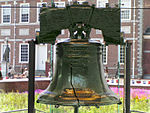
Major cities Cities and towns
50k-99kBensalem • Camden • Cherry Hill • Gloucester Township • Levittown • Reading • Trenton • Vineland • WilmingtonCities and towns
25k-50kCategories:- Pennsylvania counties
- Bucks County, Pennsylvania
- States and territories established in 1682
Wikimedia Foundation. 2010.

